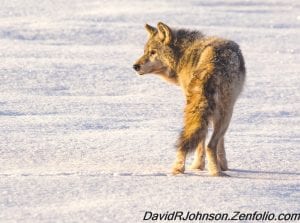With fewer than 10 wolves left on Isle Royale, the fact that two wolves crossed an ice bridge and spent five days on the island was exciting. Unfortunately the two wolves decided to return to the mainland. This old wolf, caught on camera by local photographer David R. Johnson, was on the mainland and is not one of the wolves that took the 14-mile journey across the ice.

With wolves nearing extinction on Isle Royale, a collared wolf and partner from the Grand Portage area caused quite a stir of excitement when they crossed an ice bridge over to the Big Island. With fewer than 10 wolves left on the island, it was hoped the two wolves would stay and help regenerate the dwindling population and refresh the gene pool.
Alas, the two wolves were just on a five-day jaunt before returning to the mainland. During their stay they didn’t breed with any other wolves, meaning no new genes were added to the pool, said Dr. Rolf Peterson.
Last winter an Isle Royale wolf named Isabella came across the frozen ice bridge only to meet her untimely demise in Grand Portage.
This year—with Lake Superior 95.5 percent frozen over for the second year in a row—a second ice bridge formed giving wolves another chance to travel to and from Isle Royale. Dr. Peterson and Dr. John Vucetich, professors at the University of Michigan Tech, have spent much of their careers studying the interaction between wolves and moose in a predation study on Isle Royale. The study undertaken by Michigan Tech faculty began in 1959 and is the longest predation study of its kind in the world.
With fewer than 10 wolves left and moose steadily increasing their numbers (from 500 in 2010 to over 1,000 now), the natural checks and balance system has gone awry, and moose have been causing problems to island vegetation due to their over browsing.
It’s not the first time the wolf population has shrunk. In 1982 there was an estimated population of 50 wolves. By 1988 researchers could count only 12 wolves living in three small packs. The problem this time is that the few remaining wolves have all interbred, leading to genetic disorders and less breeding. Wolves, like most animals, are naturally averse to inbreeding. In 2012 researchers could find no evidence of wolf pups being born. With an average lifespan of less than 5 years, Peterson and Vucetich feel that it won’t be long before the wolves on Isle Royale will disappear unless more are brought in.
When first asked about the possibility of a new wolf (or wolves) arriving on the island, Dr. Peterson said, “I am under stern orders from the National Park Service to let them ‘handle’ all media releases. These are new constraints and I’m working to have them modified, but please understand in the meantime I have to toe the government line.”
It didn’t take too long for the gag order to be suspended, and Peterson could once again talk to the media.
A big worry for researchers has been a lack of ice bridges between the mainland and the island. Wolves travel to and from the island on these bridges, but due to global warming, fewer ice bridges have been occurring over the last decade. With no access, it was and still is feared that the wolf population will disappear unless new wolves come or are brought in by man to help stabilize the population.
The National Oceanic and Atmospheric Administration (NOAA) reported on February 26 that 95.5 percent of Lake Superior was frozen. Two weeks later, the ice bridge was gone, meaning this year no new wolves will be added to Isle Royale unless some pups are born.


Leave a Reply